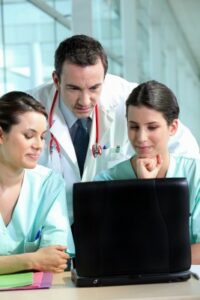Career Advice for Job Seekers
How Technology Factors Into Nursing
 The medical field, like nearly every other professional discipline today, is being continuously affected and enhanced by the development of new technology. Technology is making the study and practice of medicine easier, faster, more accurate and more relevant for medical professionals, their patients and loved ones.
The medical field, like nearly every other professional discipline today, is being continuously affected and enhanced by the development of new technology. Technology is making the study and practice of medicine easier, faster, more accurate and more relevant for medical professionals, their patients and loved ones.
Whether a medical student is enrolled in a traditional brick-and-mortar institution or is jumping on the technological bandwagon right from the start by enrolling in an online masters degree in education with an eye towards a career in medicine, technology is involved of every step of the process today for becoming a medical professional.
Many a student who intends to become a physician, a radiologist, a nurse anesthesiologist or a professional in another discipline within the medical field participates right from their student years in surveys and field studies to see how enhancements to available technology can improve both patient care and quality of life. In fact, a newly emerging hybrid field known as “nursing informatics” actually merges the complementary fields of nursing and information technology (IT) together to develop specific programs and protocols that can aid medical professionals at all levels in performing their jobs more efficiently and effectively.
Understanding the Role of Technology
While, at first glance, it may be less easy to see how critical the presence of technology really is for nurses and other medical professionals, technology has been a part of the medical field for years, albeit in more subtle ways. Pacemakers, small battery-powered electronic devices that are implanted beneath the skin to regulate heart rate, have been saving lives for decades. The electronic IV has replaced the often-erratic performance of the older manual IV models, which were prone to clogging, uneven drips, too-rapid drips and other unwelcome vagaries.
Today’s electronic blood pressure cuffs, thermometers, and other basic health monitoring devices are both more accurate and more sanitary for patients and medical professionals alike. And miraculous devices such as sonograms, ultrasounds, MRI (magnetic resonance imaging) machines and other less invasive diagnostic and testing equipment spare the patient any unnecessary pain and suffering, all while offering early detection and even prevention of life-threatening health irregularities.
Perhaps most importantly, the rise of computers has aided nurses, doctors and their staff and aides in keeping detailed notes about each and every patient with a simple click of a button. Gone are the days of cumbersome, complicated and often barely legible patient files. Today, computer-aided recordkeeping programs keep patient information in a format that is readable, accessible, searchable and transferrable, if a patient must see more than one professional about a particular issue.
Computer programs can also serve as prompters to aid nurses and doctors in collecting all of the necessary information at each and every consultation. New medically-focused software also makes use of the internet and wireless technology, allowing doctors and nurses to instantly transmit prescriptions electronically to a patient’s pharmacy, perform drug monitoring to ensure that a newly prescribed medication will not conflict with medications a patient is already taking, generate recommendations for how and when to take prescribed medications, and offer other patient educational tools as well. Other helpful tools include the ability to fill out and file required medical, insurance and authorization forms online to save time at patient check-in and check-out.
A Constant Evolution
While some medical and nursing professionals who were trained in prior years are less apt to embrace newer technology with open arms, the profession itself is changing quickly and irrevocably to favor nursing and medical professionals who are technologically savvy and interested in continuing to develop and apply new technologies to their profession. Because technology makes so many routine tasks in the nursing and medical profession faster, easier, more accurate and more detailed, it is clear that medical technology is here to stay. For professionals who have been in the medical field for some time, and wish to remain, many are choosing to return for continuing education that can train them in how to use the new equipment and technology that is now available. For students who are just graduating and becoming licensed as technology-savvy medical and nursing professionals, the field is ripe with opportunity and job openings – perhaps more now than ever before – and this, too, is a trend that is here to stay.
Kelly Reynolds is studying to be a nurse and hopes to make it as a clinical nurse leader someday soon.
New Job Postings
Advanced Search